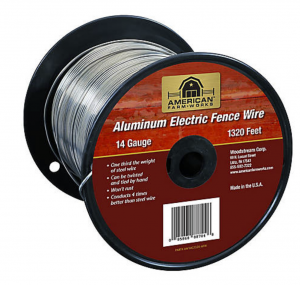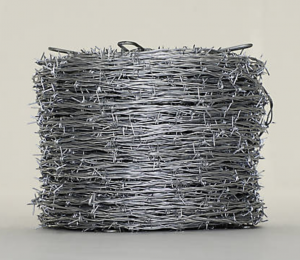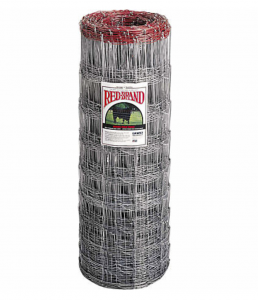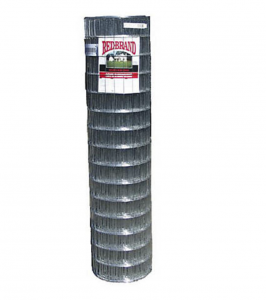There are many options for cattle fencing, and the decision of which one to choose has to factor in both functionality and financial feasibility. The best fence for cattle needs to work for you. Period. If it covers your property yet isn’t affordable, then you have to pass on it. If it’s cost-efficient yet doesn’t do the job of keeping your animals where you want them to stay, then that’s not good either. And no one wants to worry about their cattle getting loose or wandering out onto a country road to get hit by a pickup truck. There is so much at jeopardy if that happens.
Of course, you can’t just head to the farm store or pull up a website and start buying. You have to plan out exactly what you need and see where your budget lands. We had worked with Red Brand to give you the ins and outs of planning your farm fencing, and it’s definitely worth checking out here. It’s admittedly hard to wrap your head around such a large project, as the stability of corner posts and the post spacing throughout the project are among the many things you have to consider.
If you’re setting up fencing for cattle, we’re going to assume you’re looking for a permanent option, rather than more mobile temporary fencing (which some smaller producers certainly use with rotational grazing). We’ve been around a lot of animals and have seen over the years what tends to work well and which types of fencing for cattle are cutting corners and not going to help you in the long run.
For our money, here are the four products that serve us as the best fence for cattle and will hopefully give you a good launching point for your project.
High-tensile electric fencing
This type of fencing has, as you’d well expect, a charge running through it, which acts as a deterrent to cattle who may try to test it. Tractor Supply Co. explains that a fence charger should deliver 2,000 volts to 3,000 volts to the fence line, in order to keep an animal contained safely. How many strands you opt to have depends entirely on you: We’d suggest a minimum of two if you don’t have any complementary types of fencing in place), but some people have as many as five or six strands if you have animals more densely confined.
To do this kind of fencing correctly, you have to know the basics of grounding the line, because without that piece of the puzzle, you’re whole fencing system is just a waste. You also need a reliable charger, which, for example, can be plugged in, battery-powered, or solar-powered depending on your specific needs. Worth noting, too, is that, according to Michigan Extension, high-tensile wire can withstand more than 1,000 pounds of livestock pressure and low-temperature contraction without losing elasticity.
Our favorite: American FarmWorks 14-Gauge Aluminum Wire. It is a sturdy 14 gauge, has a 215-pound breaking load, and has a 38,000 PSI tensile strength.
Barbed wire fencing
There are many who aren’t fans of barbed wire fencing, but it has long been (and is today) the most popular type of cattle fencing across the country. The barb on each strand is a physical deterrent, to be sure, but this fence isn’t the best visual deterrent, especially if there are only a couple of strands. Many barbed wire setups have four or five strands to them — as with electric fencing, this largely depends on how densely the animals are housed. If you’re struggling with the number of strands, go for the more secure setup (assuming you can afford it). Cattle, like so many other livestock animals, are notorious for being able to tear down and tear through a lot of types of fencing.
Barbed wire fencing is particularly versatile and lots easier to install than some other kinds — that goes for both the wire itself and the T-posts that this type of fencing is often attached to.
Our favorite: OK Brand Premium 4 Point Barb Wire. It’s 12.5 gauge and measures 1,320 feet long. The zinc-coated barbed wire is economically priced, while still meeting ASTM standards.
Woven wire fencing
This is the overall best fencing in terms of performance, because you’re getting both a strong physical barrier as well as a good visual barrier for the animals. Also sometimes referred to as having a “fixed-knot” design, this type of fencing succeeds, in part, because there’s simply a lot more fencing per foot with this design, and like the single strand eclectic fencing, it is a durable high-tensile build.
These fences incorporate vertical and horizontal designs to create squares or rectangles that are only a couple of inches wide. It’s not uncommon to really hammer this type of fencing home by including a stand of high-tensile electric fencing at the top.
People like this kind of fencing because of its strength, however, be warned that cattle and other livestock can get their hooves caught in the openings, so it could be a health hazard if you don’t keep a close eye on things.
Our favorite: Red Brand Woven Field Fence. It measures 330 feet long and 47 inches tall. It measures in at 10 gauge and has been proven to us to last a very long time!
Welded wire fencing
When compared with woven wire, especially gauge for gauge, welded wire is going to have the same visual barrier but won’t be quite as tough when it comes to how it holds up against the animals. That’s not to say it’s weak, but it’s sort of a lighter-weight, more workable version of woven wire.
A lot of times, you can expect welded wire to have smaller openings between the square or rectangular openings, so that does lessen the concern of animals hurting themselves by getting a hoof stuck.
Our favorite: Red Brand Welded Wire. At 60 inches, it’s taller than other fencing on this list, but it’s worked well in many spots where the ground is uneven or lower than the surrounding land.
What’s the difference between permanent fencing and temporary fencing?
Temporary fencing is usually made of light yet durable materials — and some materials, such as barbed wire, can work for both temporary and permanent fencing. Generally, temporary fencing materials are electrified because it’s very easy for animals to tear down the fencing. Permanent fencing, on the other hand, is where you’ll see woven wire, wood rails, or something else heavy-duty. They are much more appropriate for long-term use. Some farmers choose to include temporary fencing materials like tape or wire fencing along with PVC or wood rails to fortify the barrier. If you opt for permanent fencing, you’ll likely want to concrete the posts into the ground.
What to think about when building the fence
There are four key points to have in mind when building a fence: Establish fence lines (take time to lay out the fence line carefully and know your property boundaries); set end, corner, and gate post braces (oftentimes, concrete footings will be needed); post spacing (think 8-to-12 feet apart in many instances); attach the wire (8-to-10 inches off the ground is a good rule of thumb for permanent fences).
Editor’s recommendations






